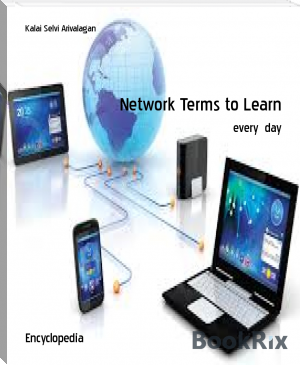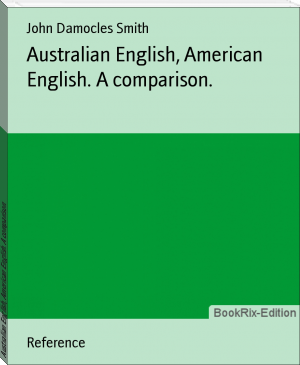Network Terms to Learn - Kalai Selvi Arivalagan (best love novels of all time .TXT) 📗

- Author: Kalai Selvi Arivalagan
Book online «Network Terms to Learn - Kalai Selvi Arivalagan (best love novels of all time .TXT) 📗». Author Kalai Selvi Arivalagan
Do What I Mean
The phrase "do what I mean" or DWIM in IT references systems in which a technology should do what user intends, rather than what the user says. One way to think about DWIM systems is that they are similar to a spell checker for a word processor. Complex commands allow that technology to go in and change likely errors by understanding the common syntax of a user error.
Iris Flower Data Set
The Iris flower data set is a specific set of information compiled by Ronald Fisher, a biologist, in the 1930s. It describes particular biological characteristics of various types of Iris flowers, specifically, the length and width of both pedals and the sepals, which are part of the flower's reproductive system. The Iris flower data set is now widely used as a data set for testing purposes in computer science.
Sensor Fusion
Sensor fusion is the use of sensory data from multiple sources, combined into one comprehensive result. Using multiple sensors, planners can generate more robust data models or obtain greater numbers of data points for the purposes of a given system.
Microkernel
A microkernel is a piece of software or even code that contains the near-minimum amount of functions and features required to implement an operating system. It provides the minimal number of mechanisms, just enough to run the most basic functions of a system, in order to maximize the implementation flexibility so it allows for other parts of the OS to be implemented efficiently since it does not impose a lot of policies.
Cryptanalysis
Cryptanalysis is the decryption and analysis of codes, ciphers or encrypted text. Cryptanalysis uses mathematical formulas to search for algorithm vulnerabilities and break into cryptography or information security systems.
Gray Code
Gray code evaluates the nature of binary code or data that is composed of on and off indicators, commonly represented by ones and zeros. Developed by Bell Labs scientists, gray code has been used to look at clarity and error correction in binary communications. Gray code is also known as reflected binary code.
AIOps
AIOps is a methodology that is on the frontier of enterprise IT operations. AIOps automates various aspects of IT and utilizes the power of artificial intelligence to create self-learning programs that help revolutionize IT services.
Social Media Hermit
A social media hermit is an individual who avoids any form of online sharing. With the increasing societal pressures to be searchable on social media platforms, the number of social media hermits is constantly declining. One of the headwinds facing social media hermits is the trend for recruiters and human resource professionals to rely on online networks such as LinkedIn to send out new postings, as well as the new emphasis on social media experience in many professional jobs.
Business Intelligence 2.0
Business intelligence 2.0 (BI 2.0) refers to business tools and technologies that provide new and unique features and capabilities. BI 2.0 differs from traditional data querying methods of business intelligence in that it incorporates service-oriented architecture and Web 2.0, thus bringing a more Web- and browser-based approach to information gathering. Business intelligence focuses more on the context of data streams and on the insight rather than just information.
ABAP Objects
ABAP Objects are the object-oriented extension introduced in 1999 to the original ABAP (Advanced Business Application programming) language and ABAP Workbench from R/3 release 4.6 and on. This fully integrated extension endows ABAP with object-oriented features for the design and implementation of object-oriented programs. Programs in ABAP may or may not contain ABAP Objects, at the programmer’s discretion.
IT Risk Management
IT risk management is the application of the principles of risk management to an IT organization in order to manage the risks associated with the field. IT risk management aims to manage the risks that come with the ownership, involvement, operation, influence, adoption and use of IT as part of a larger enterprise.
IT risk management is a component of a larger enterprise risk management system. This encompasses not only the risks and negative effects of service and operations that can degrade organizational value, but it also takes the potential benefits of risky ventures into account.
Dark Web
The dark Web is comprised of websites that are visible to the public, but their IP address details are intentionally hidden. These websites can be visited by anyone on Internet, but it is not easy to find the server details on which the corresponding site is running, and it is difficult to track the one hosting the site. The dark Web concept is achievable with the help of anonymity tools. Some popular tools are Tor and I2P. The dark Web is popular for both black market and user protection, so it has both positive and negative aspects.
Self-Supervised Learning (SSL)
Self-supervised learning (SSL) is an approach to machine learning allows machine learning algorithms to use observed inputs to predict unknown inputs. An important goal for self-supervised learning is to programmatically change unsupervised learning models into supervised learning models by developing pre-training deep learning systems that can learn to fill in missing information.
BERT (Bidirectional Encoder Representations from Transformers) and Q Learning are perhaps two of the most well-known applications of self-supervised learning in AI. During the pre-training phase, each system is shown a short example of text in which some of the words are missing. The systems are then trained how to extract supervisory signals from the input data in order to predict the missing words accurately. SSL and has played an important role in the development of natural language processing (NLP). It is one of several approaches being studied to reduce the need for massive amounts of data to train AI learning algorithms.
Term of the day-9Recurrent Neural Network
A recurrent neural network (RNN) is a type of advanced artificial neural network (ANN) that involves directed cycles in memory. One aspect of recurrent neural networks is the ability to build on earlier types of networks with fixed-size input vectors and output vectors.
Fauxtography
Fauxtography refers to fraudulent photography, where photographs are manipulated through photoshop or manipulated by other means to change the information they convey. Fauxtography is often used to manipulated the viewer and promote a particular agenda.
Fauxtography is also occassionally used to refer to low-quality or humorous photographs taken by amateur photographers who have started photography businesses or blogs despite their limited experience and skill. In this sense, fauxtography is an Internet meme. "Faux" is the French word for "fake."
Superintelligence
A superintelligence is an intelligence system that rapidly increases its intelligence in a short time, specifically, to surpass the cognitive capability of the average human being. Superintelligence has been used in science fiction, and in discussions around artificial intelligence, to understand some of the ramifications of a quickly evolving intelligence model in IT.
NetWeaver
NetWeaver is an application builder designed to integrate multiple business processes and databases. NetWeaver was created by SAP AG and it enables the integration of information and processes from many geographical locations.
Cognitive Architecture
Cognitive architecture is a hypothesis inspired by the human mind in which systems work together along with the necessary resources to attain intelligent behavior in any complex environment. Cognitive architecture's aim is the development of artificial agents that support the same capabilities as that of the human mind. In other words, it focuses on the tight integration between cognitive science and artificial intelligence.
Memory Overcommit
Memory overcommit is a process in which a virtual machine (VM) is assigned more memory than a host machine's available and committed physical memory. It is used in virtualization environments to allocate memory capacity to VMs with higher requirements.
Theoretical Computer Science
Theoretical computer science is a term generally used to refer to parts of the computer science world that are less "hands-on" or demonstrable and more theoretical in nature. IT professionals who discuss theoretical computer science are often talking about some of the more mathematical and esoteric ideas about computing, and some of the more theoretical applications of technologies like algorithms, data structures and cryptography.
Zope
Z Object Publishing Environment (Zope) is an open source Web Server built using Python. It encompasses a transactional database that stores content, HTML templates, scripts and features a search engine along with a RDBMS. Zope simplifies the creation of dynamic Web apps and offers application-based support such as membership, news and search. Zope is built completely using open standards such as XML-RPC, DOM and WebDAV.
Concatenation
Concatenation, in the context of programming, is the operation of joining two strings together. The term"concatenation" literally means to merge two things together. Also known as string concatenation.
Session Initiation Protocol Trunking
Session Initiation Protocol (SIP) trunking is a specific method involved in Voice Over Internet Protocol (VoIP) or similar systems. VoIP is a method associated with the Private Branch Exchange (PBX) systems used in modern businesses to provide unified communications to enterprise and drive Internet telephony solutions.
Hard Fork
A hard fork in the world of bitcoin and cryptocurrency is a phenomenon in which a change forces certain divergences in the blockchain, as a result of miner or user activity or a change in rules. In the world of cryptocurrency, there are hard forks and soft forks; unlike a soft fork, a hard fork does not resolve automatically according to user trends.
Microkernel
A microkernel is a piece of software or even code that contains the near-minimum amount of functions and features required to implement an operating system. It provides the minimal number of mechanisms, just enough to run the most basic functions of a system, in order to maximize the implementation flexibility so it allows for other parts of the OS to be implemented efficiently since it does not impose a lot of policies.
Groovy
Groovy is a programming language with more compact syntax than Java and designed for dynamically compiled runtime data execution on Java Virtual Machine (JVM). Groovy uses all Java classes and libraries and builds nicely on Java’s strengths, which allows for more efficient coding. Groovy's features are similar to Python, Ruby and Smalltalk and include support for static and dynamic typing, closures, operator.
Cloud Security Control
Cloud security control is a set of controls that enables cloud architecture to provide protection against any vulnerability and mitigate or reduce the effect of a malicious attack. It is a broad term that consists of the all measures, practices and guidelines that must be implemented to protect a cloud computing environment.
Db2 (DB/2)
Db2 is a line of data management products from IBM. It includes a well-known relational database management system (RDMS) that IBM introduced in 1983 to run on its MVS (Multiple Virtual Storage) mainframe platform. The name DB/2 originally referred to IBM's shift from a hierarchical database model to the relational database model. IBM rebranded the line of database products Db2 in 2017.
Although DB2 was initially designed to work exclusively on IBM mainframe platforms, it was later ported to other widely used operating systems, including UNIX, Windows and Linux and now supports non-relational structures such as JSON and XML. Today, Db2 plays an integral part of IBM’s information management portfolio both locally and in the cloud, making it possible for organizations of varying sizes to handle large quantities of data and serve large number of users concurrently.





Comments (0)